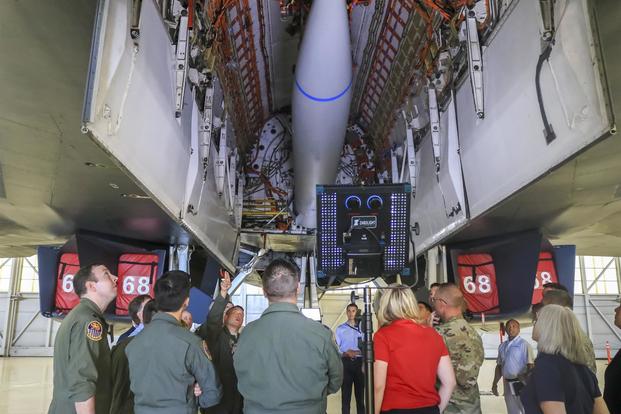The Air Force has just proved that the B-1B Lancer bomber can be modified to hold more ordnance -- a step that may pave the way to future hypersonic weapons payloads.
Air Force Global Strike Command, in partnership with 419th Flight Test Squadron, Edwards Air Force Base, California, recently showed off the ability to increase the payload capacity of the conventional-weapons bomber, according to a recent news release.
Teams demonstrated how crews could fasten new racks onto the external hardpoints of the B-1, and reconfigure its internal bomb bays to hold heavier weapons, officials said in the release.
Related: What's on a B-1B Lancer Aircrew's Wish List? Room for More Bombs
"The purpose of the demonstration was to show that we're still able to move the bulkhead from the forward intermediate bay to the forward location, increasing the intermediate bay capacity from 180 inches to 269 inches," Lt. Col. Dominic Ross, chief of B-1 requirements and director of strategic plans, programs and requirements for AFGSC, said in the release. "Additionally, we demonstrated that we can still carry weapons externally on six of the eight hard points, which increases our overall carriage capacity."
Ross previously advocated for the B-1 to get modified to hold more bombs in an interview with Military.com in 2017.
The long-range aircraft already has three types of racks that it carries in each of its three bomb bays, which are known as the forward weapons, intermediate and rear AFT.
So far, the external carriage and long bay projects are just experimental; but the Air Force could use them to give the non-nuclear bomber some greater storage volume, and even add hypersonic weapons into the mix one day, Ross said.
"Currently we can carry 24 weapons internally, [but] now it can be increased to potentially 40 based on what type of pylon we would create," Ross said. "This gets the B-1 into the larger weapons, the 5,000 pounders. It gets it into the hypersonics game as well."
The bomber was equipped with a hypersonic missile mock-up attached to a conventional rotary launcher during the demonstration, officials said. The launcher was the same used on the B-52H Stratofortress.
B-1 bomb bays are already snug for conventional weapons, and hypersonic weapons -- which would travel at speeds of Mach 5 or higher -- would take up more space just by the complexity of their propulsion design.
These potential modifications aren't permanent, added Capt. Timothy Grace, test weapons systems officer for the 419th Flight Test Squadron.
"It's something that can be done through a few work shifts with the maintenance (flight)," he said. "So depending on what the targets are that we're going after, the weapons we need to carry, we can move that bulkhead and do the external carriage."
Currently, the B-1 can carry 75,000 pounds of both precision-guided and conventional bombs.
"It really shows the aircraft was originally designed for that capability," said Col. Richard Barksdale, 28th Operations Group commander, Ellsworth Air Force Base, South Dakota.
"To move that bulkhead forward and make a larger bay, it shows the forethought of the original engineers and now, that can potentially come into fruition," Barksdale added. "To me, just the opportunity to increase the weapons-load capacity is pretty exciting."
The Air Force might find itself needing to make a decision on potential modifications soon. Officials announced last year that the service plans to retire the bombers in 2036.
-- Oriana Pawlyk can be reached at oriana.pawlyk@military.com. Follow her on Twitter at @oriana0214.
Read more: Proposed Cannon Would Turn the B-1 Bomber into a Gunship












